Abstract
We used positron emission tomography (PET) to examine the role of the hippocampal formation in implicit and explicit memory. Human volunteers studied a list of familiar words, and then they either provided the first word that came to mind in response to three-letter cues (implicit memory) or tried to recall studied words in response to the same cues (explicit memory). There was no evidence of hippocampal activation in association with implicit memory. However, priming effects on the implicit memory test were associated with decreased activity in extrastriate visual cortex. On the explicit memory test, subjects recalled many target words in one condition and recalled few words in a second condition, despite trying to remember them. Comparisons between the two conditions showed that blood-flow increases in the hippocampal formation are specifically associated with the conscious recollection of studied words, whereas blood-flow increases in frontal regions are associated with efforts to retrieve target words. Our results help to clarify some puzzles concerning the role of the hippocampal formation in human memory.
Full text
PDF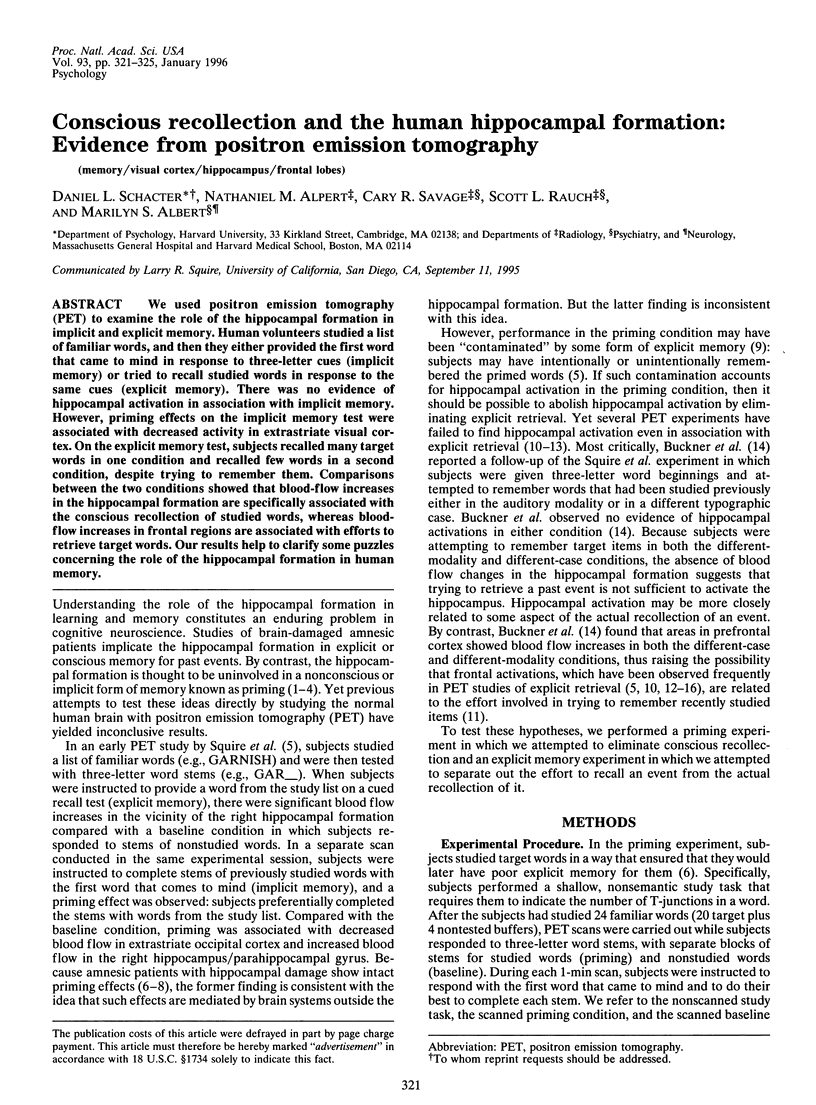
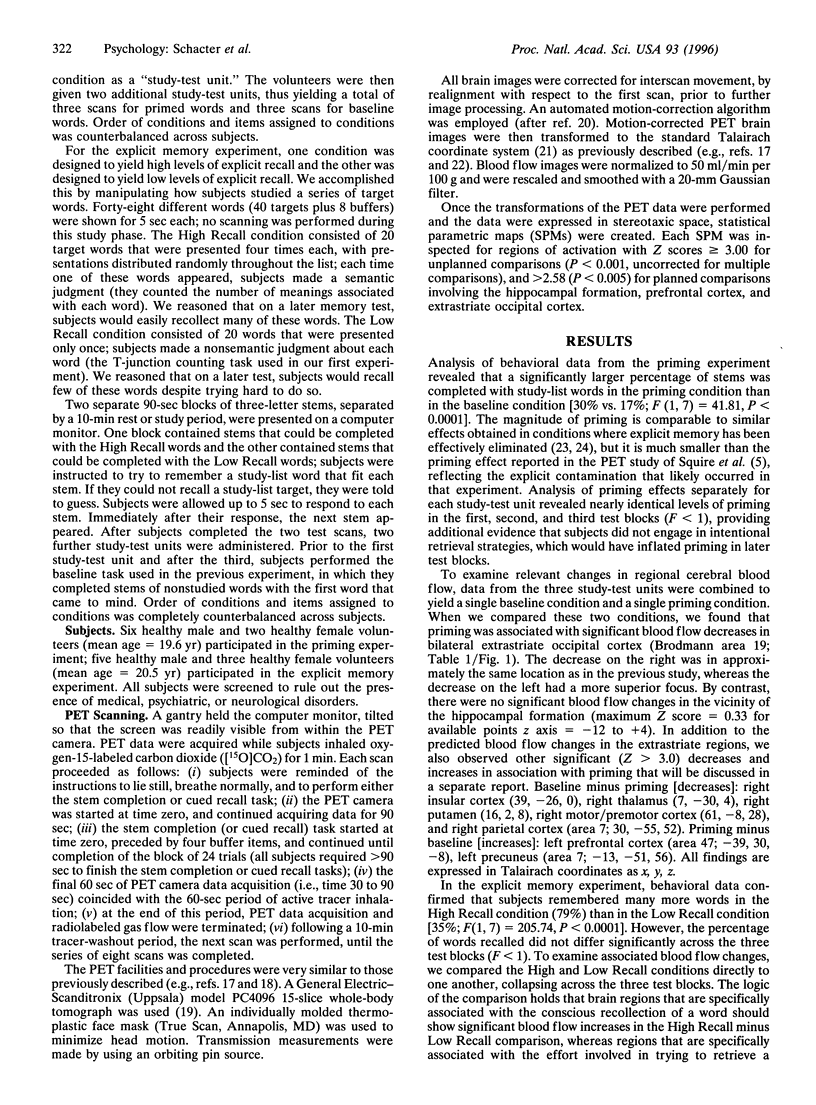
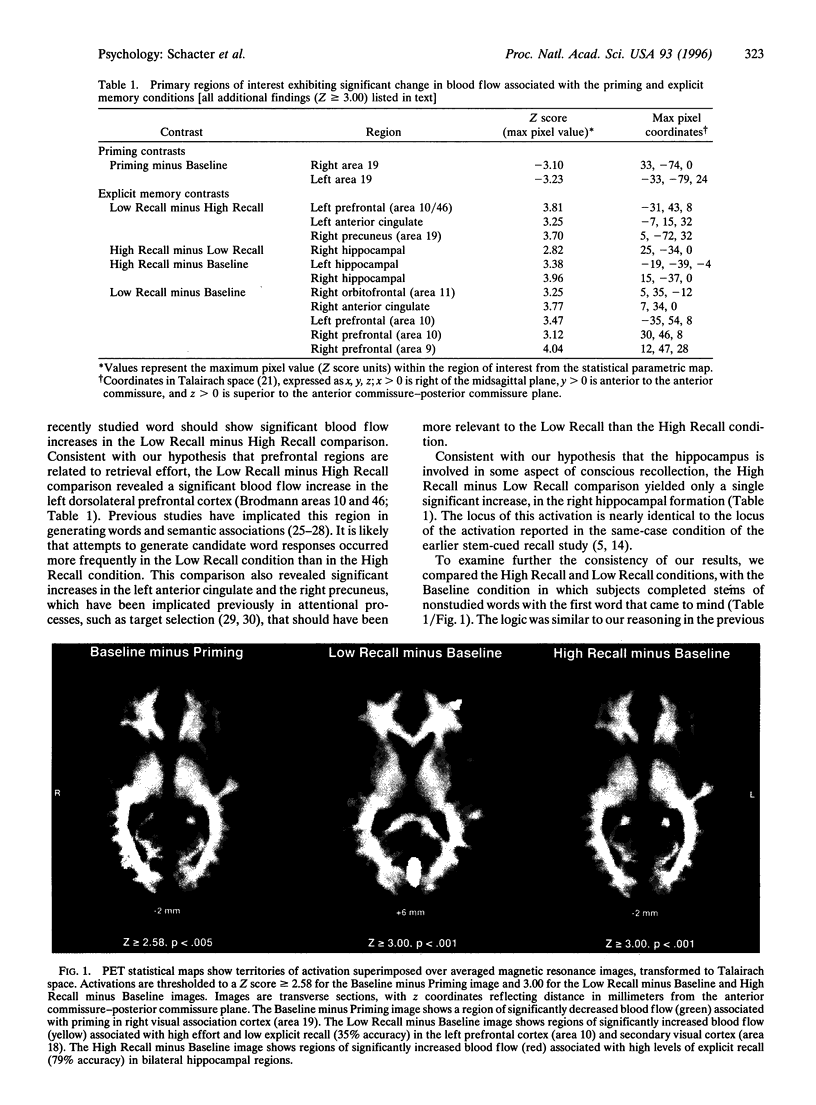
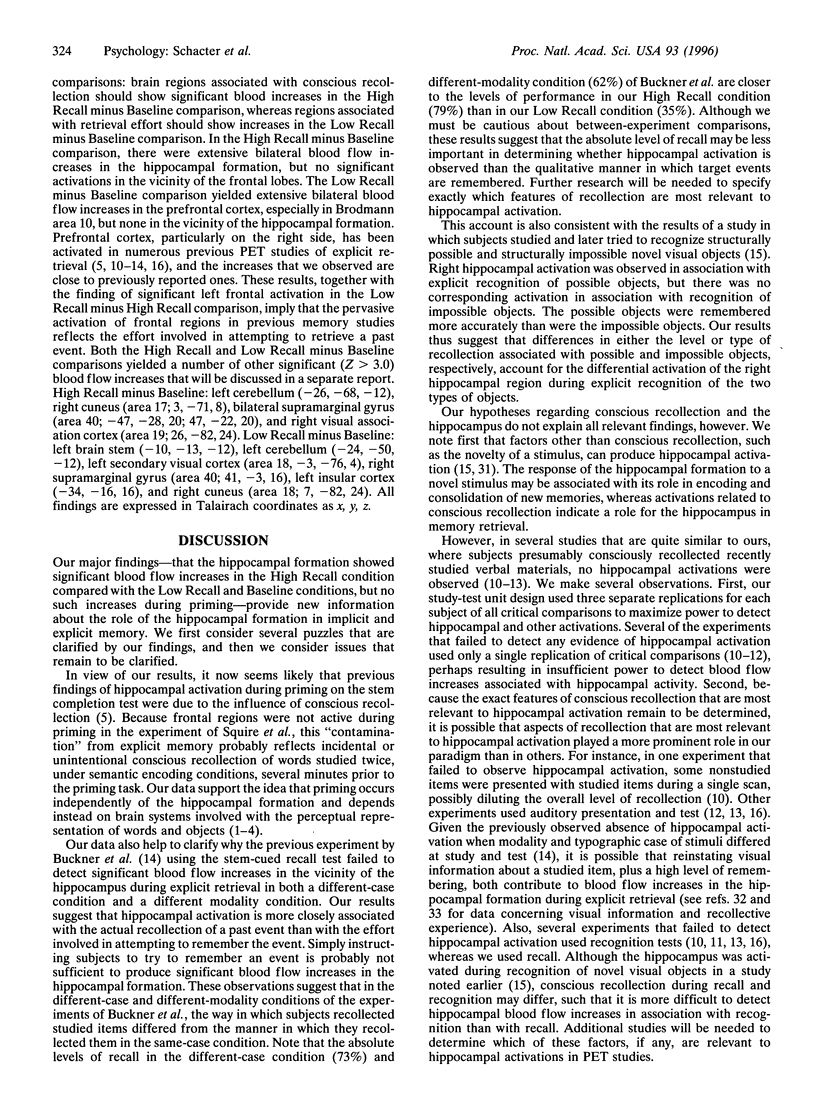
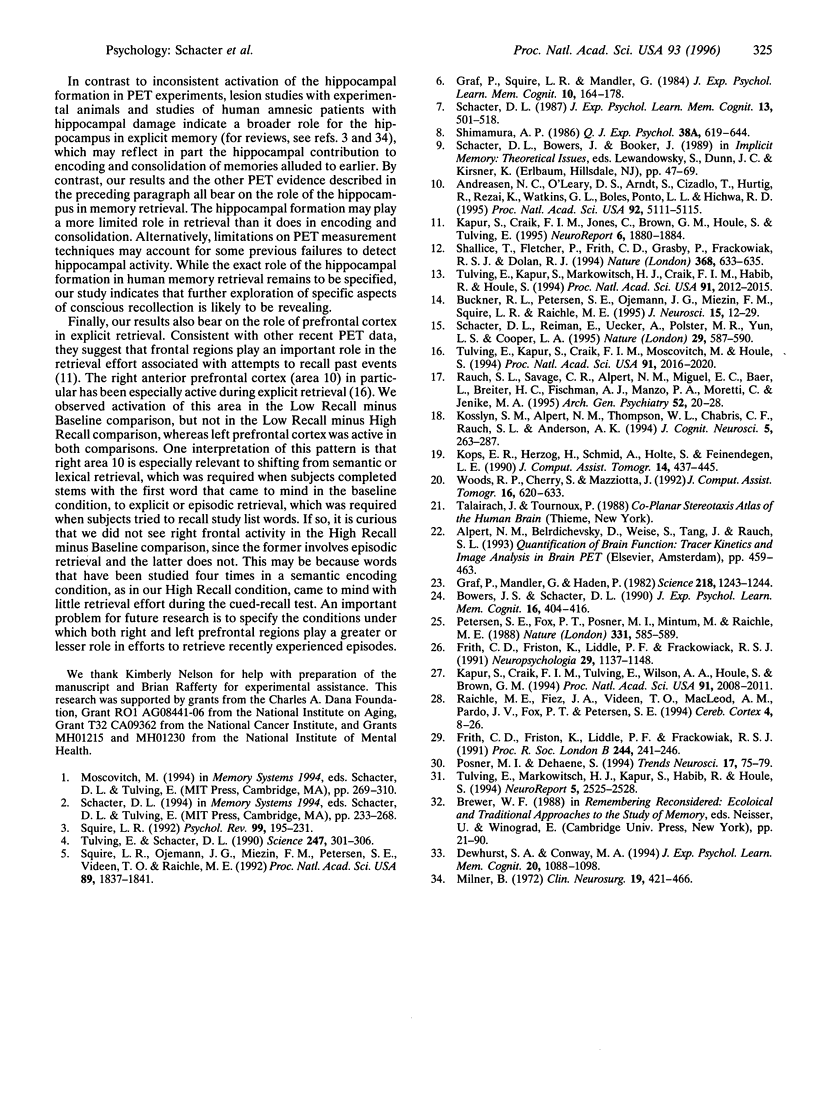
Images in this article
Selected References
These references are in PubMed. This may not be the complete list of references from this article.
- Andreasen N. C., O'Leary D. S., Arndt S., Cizadlo T., Hurtig R., Rezai K., Watkins G. L., Ponto L. L., Hichwa R. D. Short-term and long-term verbal memory: a positron emission tomography study. Proc Natl Acad Sci U S A. 1995 May 23;92(11):5111–5115. doi: 10.1073/pnas.92.11.5111. [DOI] [PMC free article] [PubMed] [Google Scholar]
- Bowers J. S., Schacter D. L. Implicit memory and test awareness. J Exp Psychol Learn Mem Cogn. 1990 May;16(3):404–416. doi: 10.1037//0278-7393.16.3.404. [DOI] [PubMed] [Google Scholar]
- Buckner R. L., Petersen S. E., Ojemann J. G., Miezin F. M., Squire L. R., Raichle M. E. Functional anatomical studies of explicit and implicit memory retrieval tasks. J Neurosci. 1995 Jan;15(1 Pt 1):12–29. doi: 10.1523/JNEUROSCI.15-01-00012.1995. [DOI] [PMC free article] [PubMed] [Google Scholar]
- Dewhurst S. A., Conway M. A. Pictures, images, and recollective experience. J Exp Psychol Learn Mem Cogn. 1994 Sep;20(5):1088–1098. doi: 10.1037//0278-7393.20.5.1088. [DOI] [PubMed] [Google Scholar]
- Frith C. D., Friston K. J., Liddle P. F., Frackowiak R. S. A PET study of word finding. Neuropsychologia. 1991;29(12):1137–1148. doi: 10.1016/0028-3932(91)90029-8. [DOI] [PubMed] [Google Scholar]
- Frith C. D., Friston K., Liddle P. F., Frackowiak R. S. Willed action and the prefrontal cortex in man: a study with PET. Proc Biol Sci. 1991 Jun 22;244(1311):241–246. doi: 10.1098/rspb.1991.0077. [DOI] [PubMed] [Google Scholar]
- Graf P., Mandler G., Haden P. E. Simulating amnesic symptoms in normal subjects. Science. 1982 Dec 17;218(4578):1243–1244. doi: 10.1126/science.7146909. [DOI] [PubMed] [Google Scholar]
- Graf P., Squire L. R., Mandler G. The information that amnesic patients do not forget. J Exp Psychol Learn Mem Cogn. 1984 Jan;10(1):164–178. doi: 10.1037//0278-7393.10.1.164. [DOI] [PubMed] [Google Scholar]
- Kapur S., Craik F. I., Jones C., Brown G. M., Houle S., Tulving E. Functional role of the prefrontal cortex in retrieval of memories: a PET study. Neuroreport. 1995 Oct 2;6(14):1880–1884. doi: 10.1097/00001756-199510020-00014. [DOI] [PubMed] [Google Scholar]
- Kapur S., Craik F. I., Tulving E., Wilson A. A., Houle S., Brown G. M. Neuroanatomical correlates of encoding in episodic memory: levels of processing effect. Proc Natl Acad Sci U S A. 1994 Mar 15;91(6):2008–2011. doi: 10.1073/pnas.91.6.2008. [DOI] [PMC free article] [PubMed] [Google Scholar]
- Milner B. Disorders of learning and memory after temporal lobe lesions in man. Clin Neurosurg. 1972;19:421–446. doi: 10.1093/neurosurgery/19.cn_suppl_1.421. [DOI] [PubMed] [Google Scholar]
- Petersen S. E., Fox P. T., Posner M. I., Mintun M., Raichle M. E. Positron emission tomographic studies of the cortical anatomy of single-word processing. Nature. 1988 Feb 18;331(6157):585–589. doi: 10.1038/331585a0. [DOI] [PubMed] [Google Scholar]
- Posner M. I., Dehaene S. Attentional networks. Trends Neurosci. 1994 Feb;17(2):75–79. doi: 10.1016/0166-2236(94)90078-7. [DOI] [PubMed] [Google Scholar]
- Raichle M. E., Fiez J. A., Videen T. O., MacLeod A. M., Pardo J. V., Fox P. T., Petersen S. E. Practice-related changes in human brain functional anatomy during nonmotor learning. Cereb Cortex. 1994 Jan-Feb;4(1):8–26. doi: 10.1093/cercor/4.1.8. [DOI] [PubMed] [Google Scholar]
- Rauch S. L., Savage C. R., Alpert N. M., Miguel E. C., Baer L., Breiter H. C., Fischman A. J., Manzo P. A., Moretti C., Jenike M. A. A positron emission tomographic study of simple phobic symptom provocation. Arch Gen Psychiatry. 1995 Jan;52(1):20–28. doi: 10.1001/archpsyc.1995.03950130020003. [DOI] [PubMed] [Google Scholar]
- Rota Kops E., Herzog H., Schmid A., Holte S., Feinendegen L. E. Performance characteristics of an eight-ring whole body PET scanner. J Comput Assist Tomogr. 1990 May-Jun;14(3):437–445. doi: 10.1097/00004728-199005000-00022. [DOI] [PubMed] [Google Scholar]
- Schacter D. L., Reiman E., Uecker A., Polster M. R., Yun L. S., Cooper L. A. Brain regions associated with retrieval of structurally coherent visual information. Nature. 1995 Aug 17;376(6541):587–590. doi: 10.1038/376587a0. [DOI] [PubMed] [Google Scholar]
- Shallice T., Fletcher P., Frith C. D., Grasby P., Frackowiak R. S., Dolan R. J. Brain regions associated with acquisition and retrieval of verbal episodic memory. Nature. 1994 Apr 14;368(6472):633–635. doi: 10.1038/368633a0. [DOI] [PubMed] [Google Scholar]
- Shimamura A. P. Priming effects of amnesia: evidence for a dissociable memory function. Q J Exp Psychol A. 1986 Nov;38(4):619–644. doi: 10.1080/14640748608401617. [DOI] [PubMed] [Google Scholar]
- Squire L. R. Memory and the hippocampus: a synthesis from findings with rats, monkeys, and humans. Psychol Rev. 1992 Apr;99(2):195–231. doi: 10.1037/0033-295x.99.2.195. [DOI] [PubMed] [Google Scholar]
- Squire L. R., Ojemann J. G., Miezin F. M., Petersen S. E., Videen T. O., Raichle M. E. Activation of the hippocampus in normal humans: a functional anatomical study of memory. Proc Natl Acad Sci U S A. 1992 Mar 1;89(5):1837–1841. doi: 10.1073/pnas.89.5.1837. [DOI] [PMC free article] [PubMed] [Google Scholar]
- Tulving E., Kapur S., Craik F. I., Moscovitch M., Houle S. Hemispheric encoding/retrieval asymmetry in episodic memory: positron emission tomography findings. Proc Natl Acad Sci U S A. 1994 Mar 15;91(6):2016–2020. doi: 10.1073/pnas.91.6.2016. [DOI] [PMC free article] [PubMed] [Google Scholar]
- Tulving E., Kapur S., Markowitsch H. J., Craik F. I., Habib R., Houle S. Neuroanatomical correlates of retrieval in episodic memory: auditory sentence recognition. Proc Natl Acad Sci U S A. 1994 Mar 15;91(6):2012–2015. doi: 10.1073/pnas.91.6.2012. [DOI] [PMC free article] [PubMed] [Google Scholar]
- Tulving E., Markowitsch H. J., Kapur S., Habib R., Houle S. Novelty encoding networks in the human brain: positron emission tomography data. Neuroreport. 1994 Dec 20;5(18):2525–2528. doi: 10.1097/00001756-199412000-00030. [DOI] [PubMed] [Google Scholar]
- Tulving E., Schacter D. L. Priming and human memory systems. Science. 1990 Jan 19;247(4940):301–306. doi: 10.1126/science.2296719. [DOI] [PubMed] [Google Scholar]
- Woods R. P., Cherry S. R., Mazziotta J. C. Rapid automated algorithm for aligning and reslicing PET images. J Comput Assist Tomogr. 1992 Jul-Aug;16(4):620–633. doi: 10.1097/00004728-199207000-00024. [DOI] [PubMed] [Google Scholar]



